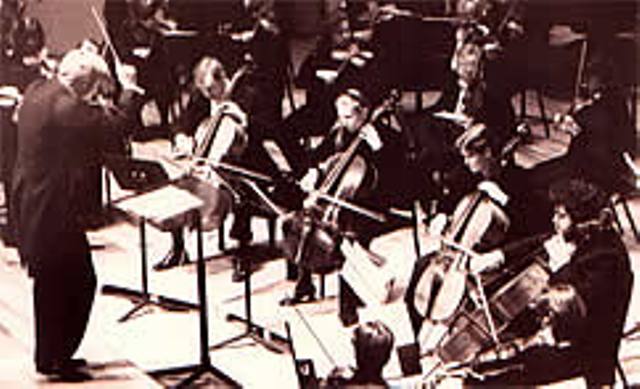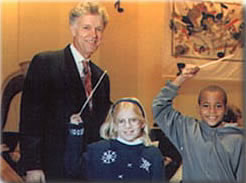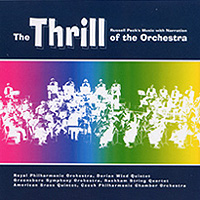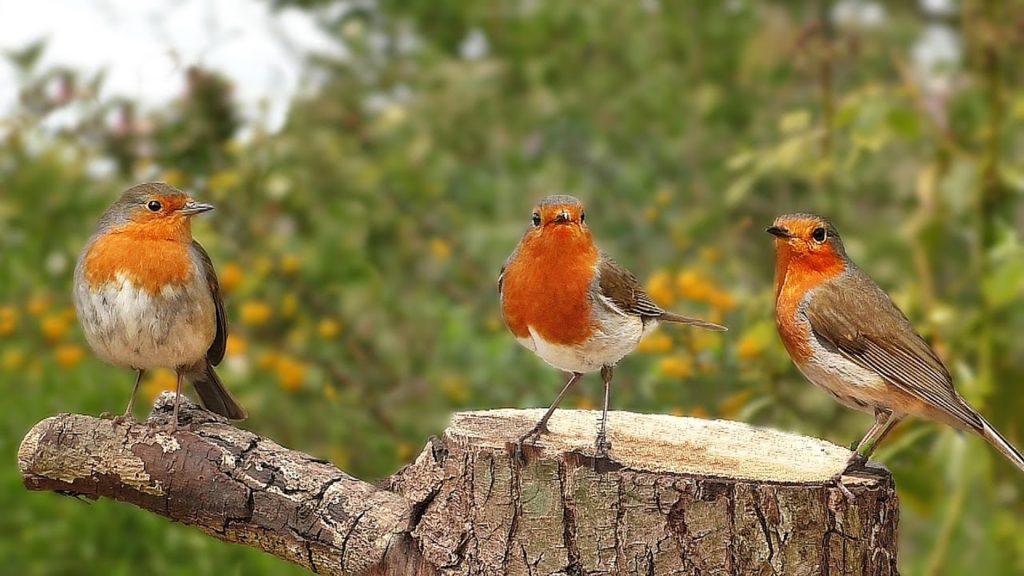Orchestral Works:
Signs of Life II- for string orchestra
Signs of Life- for string orchestra
Peace Overture- for orchestra
Gabriel– concert overture for orchestra
Don’t Tread on Me– for string orchestra
Mozart Escapes– settings of Mozart for orchestra
Ultra-Americana– two pieces for orchestra
Freedom Fanfare– for orchestra
Revolutionary Action– for orchestra
Concertos:
Voice of the Wood– concerto for cello quartet and orchestra
The Glory and the Grandeur– concerto for percussion trio and orchestra
Harmonic Rhythm– concerto for timpani and orchestra
The Upward Stream– concerto for tenor saxophone and orchestra
Educational & Family Pieces:
The Thrill of the Orchestra– demonstrates the instruments of the orchestra with narration
The Thrill Beyond Words (instrumental)
Playing with Style– demonstration piece for narrator and orchestra
Jack and Jill at Bunker Hill– a story from the founding of the USA for narrator and orchestra
Where’s Red Robin?– story piece with narrator and orchestra
Concerto for Cello Quartet and Orchestra
or
Arrangement for Cello Quartet and Piano

conducted by Peter McCopplin
I. Prelude
II. Fantasia
Composed for the innovative medium of cello quartet and orchestra. Voice of the Wood was premiered by the Charlotte Symphony to standing and shouting applause. Suitable for performance by an orchestra’s own cellists, it can also be performed by a guest artists cello quartet.
“classic Peck, tonal and accessible, and driven by syncopation . . . especially winning was the rich collective voice of the four soloists . . . the audience responded with an extended ovation”
Charlotte Observer
“very positive response . . . the audience was on its feet just moments after the music ended”
National Public Radio: Performance Today
duration: 21′
(1999)
3(3rd db. picc.)/2+E.h./2+b.cl./2+cbn. 4/3/3/1
timp. 3 perc. piano harp
violin I & II violas basses
solo cello quartet
To purchase this contact:
Eble Music Co. (319) 338-0313 www.eble.com
demonstration piece for orchestra with narration

With wit and fun, this popular “concerto for conductor” uses engaging music and narration to illustrate the conductor’s role and the basics of crescendo, diminuendo, accelerando, ritardando, legato and staccato. This work is also designed to permit narration by the conductor. Playing With Style works naturally on any program dealing with the role of the conductor or the elements of music.
Russell has composed a variety of narrated pieces appropriate for a broad range of ages. These works have been performed throughout the United States, Canada, and in Europe and Asia.
Commissioned by a consortium of North Carolina orchestras, this work has been performed by the Rochester Philharmonic, Indianapolis Symphony, and dozens of other orchestras across the country.

duration: 10′
(1991)
2/2/2/2
4/2/3/1
timp. 2 perc. strings
narrator (or conductor narration)
A
chamber orchestra version (using different score
& parts) has instrumentation as follows:
2/2/2/2 2/2/1/1
timp. 1 perc. (or timp./perc. 1
player) strings
narrator (or conductor narration)
Russell Peck, narrator; Greensboro Symphony Orchestra
Stuart Malina, conductor
nature story piece for narrator and orchestra

Illustrating a full range of musical emotions, “The Robin” tells a nature story of joy, sadness, humor, mystery, dramatic danger, and a happy ending of springtime return – taking the young listener on a tour of vivid emotional expression in the orchestra to match the moods of its storybook-style poetic narration.
Performed by the Atlanta, Cincinnati, and Milwaukee Symphonies and many others.
“amusing,
wonderfully well-orchestrated . . . received with wild
enthusiasm”
Indianapolis News
“instantly
effective . . . the Symphony rarely gets more sincere
ovations”
New Orleans States Item
duration: 17′, with options for reduced duration
(1995/1973)
3(3rd
db. picc.)/3/2+E-flat/2+cbn. 4/3/3/1
timp. 2 perc. piano harp
strings narrator
[The orchestra may be reduced by the omission of any or all of the following instruments: fl. II, oboe III, clar. II, cbn., tpt. III. Cues for these instruments are provided in other parts.]
for orchestra

The Thrill Beyond Words is a purely instrumental version of The Thrill of the Orchestra, a pocket-sized (11 minute) concerto for orchestra. It allows one to hear the music of Russell’s best-known piece, and its distinctive showcase of orchestral forces, without narration. The premiere performance was by the Greensboro Symphony Youth Orchestra, conducted by its Music Director Bruce Kiesling. This was part of the 75th anniversary multi-media show honoring the historical Carolina Theatre, which commissioned the work.
duration:
11′
(2002)
3(3rd db.
picc.)/2+E.h./2+b.cl./2+cbn. 4/3/3/1
timp. 3 perc. strings
narrator
[The full-size orchestra may be reduced by the omission of any or all of the following instruments: fl. III, E.h., b.cl., cbn., tpt. III, perc. III. Cues for these instruments are provided in other parts.]
Performances: Royal Philharmonic Orchestra
Alfred Savia, conducto
For more information, review comments, etc. about this piece under the ORCHESTRAL WORKS listing, click here.
Instrument Demonstration Piece for Narrator and Orchestra

Living up to its title, The Thrill of the Orchestra colorfully illustrates the instruments and how they are played. Suitable for all audiences, young and adult.
Frequently performed and repeated by many major American and foreign orchestras (Pittsburgh, Atlanta, Montreal, Royal Philharmonic, etc.) and more than 100 regional and other orchestras across the United States, “The Thrill” is a contemporary classic of the educational genre.
Translations available in German, French, and Spanish. “The Thrill” has also been performed in Cantonese, Korean, Hebrew, Portuguese and Japanese.
“always knocks the socks off the audience” Symphony Magazine
“a great advertisement for classical music . . . intersperses music with vivacious narration” Island Packet
“fresh, tuneful . . . rhythmically engaging, deftly orchestrated . . . Peck deserves a special bravo” New Jersey Star-Ledger
duration: 13′
(1985)
3(3rd db. picc.)/2+E.h./2+b.cl./2+cbn. 4/3/3/1
timp. 3 perc. strings
narrator
[The full-size orchestra may be reduced by the omission of any or all of the following instruments: fl. III, E.h., b.cl., cbn., tpt. III, perc. III. Cues for these instruments are provided in other parts
A chamber orchestra version (using different score & parts) has instrumentation as follows: 2/2/2/2 2/2/1/1 (tbn. & tuba are optional)
timp. 1 perc. (or timp./perc. 1 player) strings
narrator
for orchestra (with drum set)

Revolutionary Action is a short, high-energy rock-music piece based on the first section of Jack and Jill at Bunker Hill. The latter piece (with narration) can be heard on The Thrill of the Orchestra CD, which is available at iTunes and CD Baby.
duration: 4′
(1995)
3(3rd db. picc.)/2+E.h./2+b.cl./2+cbn. 4/3/3/1
timp. 2 perc. (incl. drumset) harp strings
[The orchestra may be reduced by the omission of any or all of the following instruments: fl. II, E.h., b.cl., cbn., tpt. III, harp. Cues for these instruments are provided in other parts.]
Recordings: introduction to Jack and Jill at Bunker Hill
two pieces for orchestra (can be played separately or as a two-movement suite)

“brimming with life . . .”
Greensboro News and
Record
“a wonderful and fun piece!”
JoAnn Falletta

“He was like a contemporary Ravel, treating popular music with a classical hand garbed in extremely precise, colorful and sparkling orchestration.” Paul Polivnick, Conductor
OUT OF THE BLUE 8’45”
Openly nostalgic with many style elements of traditional blues and Americana, this piece recalls a lazy afternoon on the prairie. Out of the Blue is a moderately paced intermezzo. The beginning has a wistful quality which opens up to a heartfelt recollection of simpler times. Out of the Blue captures a certain spirit of The American Dream and ends with a something that feels like a wide-open sky.
Out of the Blue may be performed without
Flute III/piccolo, Oboe II, E-flat Clarinet, and Contrabassoon Cues are provided in other instruments.
Note: if the oboe section has only two players, the second player doubles, playing English horn in Out of the Blue, and Oboe II in Flying on Instruments.
FLYING ON INSTRUMENTS 4’45”
Ecstatic happiness radiates from this jazz-influenced piece. Allegro vivace throughout, Flying on Instruments draws upon everything from Latin rhythms to gospel music. Massed strings and other sections featured as group soloists.
total duration: 13’30”
(1997)
3(3rd db. picc.)/2+E.h./2+E-flat/2+cbn. 4/3/3/1
timp. 3 perc. strings
Instrumentation may be reduced:
Flying on Instruments may be performed without English Horn and Contrabassoon. Cues are provided in other instruments.
Note: if the oboe section has only two players, the second player doubles, playing English horn in Out of the Blue, and Oboe II in Flying on Instruments.
American story piece for narrator and orchestra

Immensely entertaining, “Jack and Jill” combines an action-packed story of American history and idealism with music irresistible to young people. It is especially appropriate for programs on American music, storytelling in music, and family 4th of July concerts. For fun and musical excitement, this piece is hard to beat. It has been performed by the Buffalo, Dallas, and Detroit Symphonies, and many other American orchestras from the Anchorage Symphony to the Florida Philharmonic.
Russell has composed a variety of narrated pieces appropriate for a broad range of ages. These works have been performed throughout the United States, Canada, and in Europe and Asia.
“gusto
and flair . . . enthusiasm soars at children’s concert”
Grand Rapids Press
“the
Milwaukee Symphony soared . . . snippets of blues
. . . brass passages reminiscent of Motown . . . all
integrated within a more classically derived framework”
Milwaukee Journal
“joy
rings out at children’s concert . . . Peck left the
stage to cheers of a standing ovation”
New Orleans Time Picayune
duration: 9′
(1997/1976)
3(3rd
db. picc.)/2+E.h./2+b.cl./2+cbn. 4/3/3/1
timp. 2 perc. (incl. drumset)
harp strings
narrator
[The full-size orchestra may be reduced by the omission of any or all of the following instruments: fl. II, E.h., b.cl., cbn., tpt. III, harp. Cues for these instruments are provided in other parts.]
A chamber orchestra version (using different score & parts) has instrumentation as follows:
1+picc./2/2/2
2/2/1/1 (tuba is optional)
timp. 1 perc. (incl. drum set) opt.
harp strings
narrator
Signs of Life II (formerly Signs of Life) for string orchestra is rich with engaging rhythms and gorgeous melodic lines. Movement I is a spirited Allegro which grabs attention with it’s persistent rhythm and clear nod to Americana. Movement II is an Arioso, heart-stopping in its melancholy beauty. Movement III displays amazing energy and exhilaration.
The Los Angeles Times said that Signs of Life II is “filled with all manner of string techniques applied in imaginative ways. The piece is so engaging as to make one wish to hear it again, and soon.”
“fresh, accessible, well-written music”
Grand Rapids Press
“an inventive piece of music”
Salt Lake Tribune
“the rare ability to entice listeners without writing down to them…deftly scored…invigorating and deserving of repeated hearings.”
Detroit Free Press
Orchestras around the world agree. The complete work and various movements have had hundreds of performances by orchestras across the United States, and in Brazil, Canada, Finland, Germany, Hong Kong, Italy, Norway and Romania.
Signs of Life II was originally Signs of Life, a two movement piece, Arioso (6′) and Scherzo (6′).
Signs of Life II added the Allegro first movement (3’30”) to create the three-movement work.
total duration: 15’30”
(1983/1986)
full symphony strings or reduced to minimum of 3,3,2,2,1


